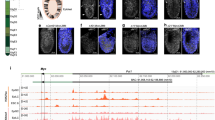Abstract
A partially asynaptic individual of the grasshopperEuchorthippus pulvinatus (2n ♂ = 16 + X) was analysed at meiosis, using a Giemsa C-banding technique. Long chromosomes formed univalents less frequently than did medium and short ones. Homologues which succeeded in forming bivalents showed reduced chiasma frequency, the long chromosomes being affected by most. Changes in chiasma distribution were also observed. The presence of univalents at metaphase I seems to affect the function of the spindle, since most cells at the second division were unreduced. Cytokinesis was also subsequently suppressed in a great number of these products of restitution, resulting in the formation of diploid and tetraploid spermatids. Fifteen tetraploid metaphase I cells were also found in which pairing level and chiasma frequency were almost twice the average value in normal diploid individuals. The nature of this mutant is discussed.
Similar content being viewed by others
References
Arana P, Santos JL, Giráldez R (1980) Chiasma interference and centromere co-orientation in a spontaneous translocation heterozygote of Euchorthippus pulvinatus gallicus (Acrididae; Orthoptera). Chromosoma 78:327–340
Baker BS, Carpenter AT, Esposito MS, Sandler L (1976) The genetic control of meiosis. Annu Rev Genet 10:53–134
Diez M, Puertas MJ (1981) Chiasma distribution in asynaptic Locusta migratoria. Chromosoma 84:431–437
Driscoll CJ, Darvey NL, Barber HN (1967) Effect of colchicine on meiosis of hexaploid wheat. Nature 216:687–688
Giráldez R, Santos JL (1981) Cytological evidence for preferences of identical over homologous but not-identical meiotic pairing. Chromosoma 82:447–451
Golubovskaya IN (1979) Genetic control of meiosis. Int Rev Cytol 58:247–290
Gottschalk W, Kaul MLH (1980a) Asynapsis and desynapsis in flowering plants. I. Asynapsis. Nucleus 23:1–5
Gottschalk W, Kaul MLH (1980b) Asynapsis and desynapsis in flowering plants. II. Desynapsis. Nucleus 23:97–120
John B, Henderson SA (1962) Asynapsis and polyploidy in Schistocerca paranensis. Chromosoma 13:114–147
John B, Lewis KR (1965) Protoplasmatologia. I. The meiotic system. Springer, Berlin Heidelberg, p 335
John B, Naylor B (1961) Anomalous chromosome behaviour in the germ line of Schistocerca gregaria. Heredity 16:187–198
Jones GH, Croft JA (1986) Surface spreading of synaptonemal complexes in locusts. II. Zygotene pairing behaviour. Chromosoma 93:489–495
Koduru PKR, Rao MK (1981) Cytogenetics of synaptic mutants in higher plants. Theor Appl Genet 59:197–214
Koller PC (1938) Asynapsis in Pisum sativum. J Genet 36:275–306
Li HW, Pao WK, Li Ch (1945) Desynapsis in common wheat. Am J Bot 32:92–101
Omara MK, Hayward MD (1978) Asynapsis in Lolium perenne. Chromosoma 67:87–96
Pi PH, Chao CY (1974) Microsporogenesis in Paspalum longifolium and P. commersonii on two different ploidy levels. Cytologia 39:453–465
Prakken R (1943) Studies of asynapsis in rye. Hereditas 29:475–495
Rees H (1957) Distribution of chiasmata in an “asynaptic” locust. Nature 180:559
Richardson MM (1935) Meiosis in Crepis. II. Failure of pairing in Crepis capillaris (L.) WALLR. J Genet 31:119–143
Rufas JS, Iturra P, de Souza W, Esponda P (1982) Simple silver staining procedure for the localization of nucleolus and nucleolar organizer under light and electron microscopy. Arch Biol 93:267–274
Santos JL, Giráldez R (1978) The effect of C-heterochromatin in chiasma terminalization in Chorthippus biguttulus L. (Acrididae, Orthoptera). Chromosoma 70:59–66
Santos JL, Giráldez R (1982) C-heterochromatin polymorphism and variation in chiasma localization in Euchorthippus pulvinatus gallicus (Acrididae, Orthoptera). Chromosoma 85:507–518
Sjödin J (1970) Induced asynaptic mutants in Vicia faba L. Hereditas 66:215–232
Soost RK (1951) Comparative cytology and genetics of asynaptic mutants in Lycopersicum esculentum MILL. Genetics 36:412–434
Thomas H, Rajhathy T (1966) A gene for desynapsis and aneuploidy in tetraploid Avena. Can J Genet Cytol 8:506–515
Zickler D, de Lares L, Moreau PJF, Leblon G (1985) Defective pairing and synaptonemal complex formation in a Sordaria mutant (spo44) with a translocated segment of the nucleolar organizer. Chromosoma 92:37–47
Author information
Authors and Affiliations
Rights and permissions
About this article
Cite this article
Santos, J.L. Differential meiotic behaviour of diploid and tetraploid cells in a partially asynaptic mutant. Chromosoma 99, 231–236 (1990). https://doi.org/10.1007/BF01731134
Received:
Revised:
Accepted:
Issue Date:
DOI: https://doi.org/10.1007/BF01731134




